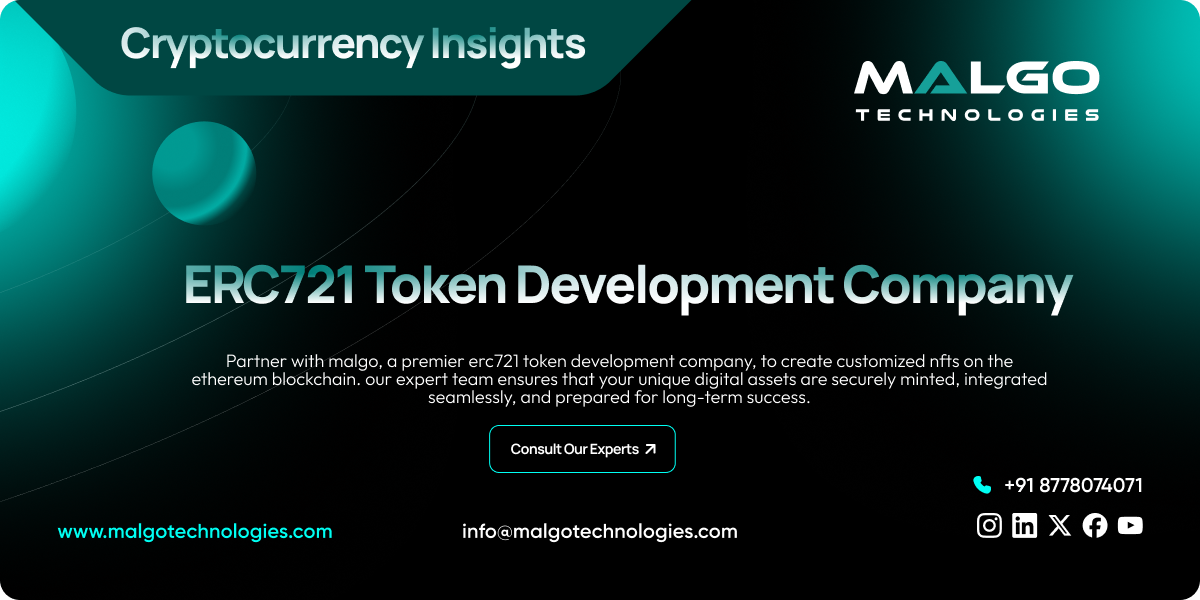Introduction
In the ever-evolving landscape of blockchain technology, Ethereum has emerged as a dominant player, offering a broad range of token standards that cater to diverse needs and industries. Among these, ERC721 tokens have gained significant popularity due to their ability to represent unique, non-fungible assets on the Ethereum blockchain. Whether you’re an artist looking to tokenize your digital art, a game developer aiming to create in-game items, or an entrepreneur building an NFT marketplace platform, understanding how ERC721 tokens work is crucial.
As an Ethereum token development company, we offer a variety of token standards to meet the requirements of our clients, including ERC20, ERC721, ERC223, ERC777, ERC827, and ERC1155. Each of these standards is designed to serve specific functionalities, from fungible token creation to multi-token ecosystems. However, in this blog, we’ll focus primarily on ERC721 tokens and their role in digital asset ownership, especially in the rapidly expanding world of NFTs.
ERC721 Tokens
ERC721 tokens are a type of non-fungible token (NFT) designed to represent unique digital assets on the Ethereum blockchain. Unlike ERC20 tokens, which are fungible (meaning each token is identical), ERC721 tokens are one-of-a-kind. Each token has distinct properties that make it different from every other token in existence. This uniqueness is one of the reasons ERC721 has become a popular choice for various applications in the blockchain space, particularly in the NFT market.
The Ethereum blockchain’s support for different token standards allows developers to choose the most suitable one for their project’s specific needs. For instance, an NFT marketplace platform would benefit from the unique features of ERC721 tokens, enabling buyers and sellers to trade exclusive digital assets.
Understanding the ERC721 Standard
What Makes ERC721 Unique?
ERC721 is a token standard that ensures the creation of unique, non-fungible tokens. The core difference between ERC721 and other token standards like ERC20 lies in the ability of ERC721 tokens to represent individual assets. This is crucial for industries that require the tracking and verification of ownership for one-of-a-kind items, such as art, collectibles, or even digital real estate.
Each ERC721 token is tied to metadata, often stored off-chain but linked through a URI (Uniform Resource Identifier). This metadata can include descriptions, images, or other details that make the asset unique. Furthermore, ownership and transaction history are securely recorded on the blockchain, providing transparency and trust.
Key Components of the ERC721 Specification
The ERC721 specification defines a set of rules and functions that allow the creation, transfer, and management of non-fungible tokens. Some of the key functions in the ERC721 standard include:
Minting: The creation of a new token, which assigns a unique ID to the asset.
Transferability: Enabling the secure and transparent transfer of tokens from one owner to another.
Metadata: Each token can be associated with metadata that defines its uniqueness.
These features are essential for creating an ecosystem where users can easily manage, buy, sell, or trade NFTs in platforms like NFT marketplaces.
From Concept to Launch: ERC721 Token Development Workflow
Creating ERC721 tokens requires a structured process to ensure that the project is secure, functional, and scalable. The development workflow typically includes the following stages:
Ideation and Use Case Analysis
Before developing an ERC721 token, it’s essential to define the use case. Whether it's for a gaming asset, digital artwork, or virtual land, understanding the value proposition of the token will determine how it is created and utilized.
Smart Contract Development
Once the use case is defined, the next step is the creation of the ERC721 smart contract. This contract governs how the token behaves, ensuring compliance with the ERC721 standard. The smart contract defines the rules for minting, transferring, and managing ownership of the tokens.
Token Minting and Metadata Structuring
Minting the tokens and structuring the metadata is a key part of the process. Tokens need to be minted according to the rules set in the smart contract, while metadata links the token to its real-world counterpart or digital asset.
Integration with Marketplaces and Wallets
For the ERC721 tokens to be traded and used within an ecosystem, they must be integrated with wallets and NFT marketplaces. This allows for easy transfer and trading of assets on various platforms.
Testing, Deployment, and Maintenance
After development, thorough testing is conducted to ensure that the tokens perform as expected. Once tested, the smart contract is deployed on the Ethereum blockchain. Ongoing maintenance is also important to ensure that the tokens remain secure and functional.
Comprehensive ERC721 Token Development Services
As a leading Ethereum token development company, we offer a variety of services to help you build and launch your ERC721-based project. Our services include:
Custom ERC721 Smart Contract Development: We create tailored smart contracts that meet the specific needs of your NFT project.
Wallet and Marketplace Integration: We ensure that your tokens are compatible with major wallets and NFT marketplaces, enabling seamless transactions.
Token Metadata and URI Management: Our team helps you manage the metadata and links associated with each token, ensuring they accurately represent the assets.
Cross-Chain Compatibility: We offer services to make sure your ERC721 tokens can interact with multiple blockchain networks, enhancing your project’s scalability.
NFT Marketplace Platform Development: We build user-friendly, secure platforms for buying, selling, and trading NFTs.
Elite Features of ERC721 Token Development
ERC721 tokens offer several unique features that make them an attractive choice for projects focused on digital asset ownership:
Immutable Ownership: Ownership details are permanently recorded on the Ethereum blockchain, making the transfer of assets transparent and secure.
Metadata Customization: Each token can have its own metadata, which can include images, descriptions, and other details specific to the asset.
Integrated Royalties: ERC721 tokens can include royalty structures that ensure creators receive compensation each time their assets are resold.
Access Control: Developers can implement whitelisting and access controls to ensure that only authorized users can access or mint tokens.
Gas Optimization: Proper contract design can help reduce transaction fees, making the process more cost-effective for users.
ERC721 Token Development Essentials: Malgo’s Tech Stack
At Malgo, we support a range of blockchain platforms and development tools to ensure a smooth and secure ERC721 token development process:
Blockchain Platforms: We support Ethereum, Polygon, BNB Chain, and other blockchain networks for token development.
Smart Contract Languages & Frameworks: Our developers are proficient in Solidity, Hardhat, and Truffle, ensuring the creation of secure and scalable smart contracts.
APIs and Middleware: We use APIs and middleware for easy integration with third-party platforms and services.
DevOps and Security: We follow best practices in DevOps and use advanced security tools to ensure the integrity and safety of your tokens.
ERC721 vs Other Ethereum Token Standards
While ERC721 is ideal for creating unique, non-fungible assets, other Ethereum token standards, such as ERC20, ERC1155, and ERC223, serve different purposes. ERC20 is best suited for fungible tokens, while ERC1155 allows the creation of both fungible and non-fungible tokens within a single contract. Choosing the right token standard depends on the specific needs of your project. For NFT platforms and unique asset creation, ERC721 remains the go-to solution for businesses looking to build a thriving NFT marketplace platform.
Security & Compliance Best Practices
Smart Contract Auditing and Testing
We conduct thorough audits and stress tests to eliminate vulnerabilities.
Regulatory Considerations for NFTs
Malgo ensures compliance with local regulations, including KYC where applicable.
Secure Metadata Storage & IPFS Integration
Metadata is stored on IPFS for decentralization and reliability.
Anti-Fraud Mechanisms
Access controls and verification processes prevent unauthorized actions.
Cost of ERC721 Token Development
Factors That Influence Cost
Project complexity, feature set, and blockchain choice impact expenses.
Budget Estimates for MVP vs Full-Scale Solutions
An MVP focuses on core functionality, while full-scale projects include advanced integrations.
Hidden Costs to Consider
Ongoing maintenance, gas fees, and audits should be factored into planning. Contact Malgo for a tailored estimate.
Why Choose Malgo for ERC721 Token Development?
Malgo stands out as a trusted Ethereum token development company with extensive expertise in developing ERC721 tokens. We offer end-to-end solutions, from ideation and smart contract development to marketplace integration and ongoing support. Our team’s experience in both blockchain development and NFT platforms ensures that your project will have the best possible foundation for success.
Conclusion
ERC721 tokens are central to the world of NFTs and unique asset ownership. As the demand for NFTs continues to rise, businesses are increasingly looking for professional developers to help them create secure, scalable, and customizable token solutions. Whether you're building an NFT marketplace platform or exploring the potential of blockchain for digital assets, ERC721 provides a powerful solution for representing and transferring ownership of unique items.
Partner with an Ethereum token development company like Malgo to leverage our expertise and technology stack to bring your ERC721 token project to life. Ready to launch your own ERC721 token? Contact Malgo today to get started!
Frequently Asked Questions
An ERC721 token is a non-fungible token (NFT) on the Ethereum blockchain, uniquely identifiable and used to represent distinct digital or physical assets. Its importance lies in enabling verifiable ownership, authenticity, and scarcity for assets like digital art, collectibles, or virtual real estate.
ERC721 supports non-fungible tokens, meaning each token is unique, unlike ERC20 tokens, which are fungible and interchangeable. Compared to ERC1155, which manages multiple token types in one contract, ERC721 focuses on individual, unique tokens, ideal for high-value assets.
Projects in digital art, gaming, virtual worlds, real estate tokenization, and intellectual property management can leverage ERC721 tokens. They enable creators and businesses to monetize unique assets and build trust through blockchain transparency.
The process includes ideation (defining token purpose), smart contract development (using Solidity and libraries like OpenZeppelin), metadata structuring (via IPFS), testing (on testnets), deployment (to mainnet), and integration with wallets or marketplaces, followed by ongoing maintenance.
Malgo conducts thorough smart contract audits, implements access controls, and uses decentralized storage like IPFS for metadata. We also apply gas optimization and anti-fraud mechanisms to protect tokens from vulnerabilities and unauthorized actions.


